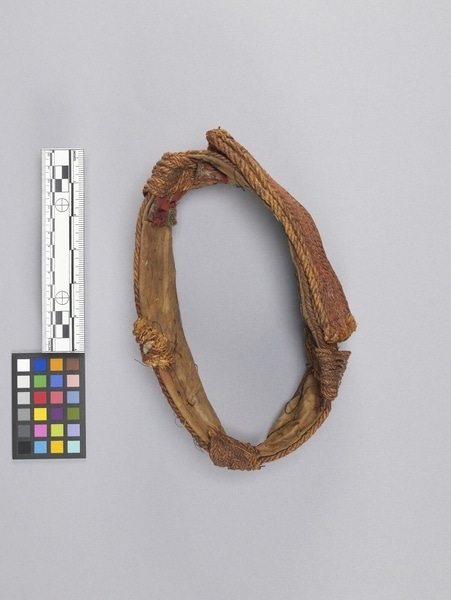Head Ring Item Number: A1467 from the MOA: University of British Columbia


Description
Head ring made from thin strands of twined cedar bark backed by cloth. Four vertical bands of twined bark are sewn to the outside of the head ring at even intervals. A wide, rectangular piece made from the same twined bark is sewn onto the front of the head ring. Possibly red pigment on bark?
History Of Use
Worn by Hamat’sa initiates. The initiate’s dance is considered by Kwakwaka’wakw people today to be the highest ranked ritual in the T’seka, or Red Cedar-Bark ceremony. It came to the Kwakwaka’wakw historically through marriage and warfare with their northern neighbours, the Wuikinuxv and the Heiltsuk. There are many differences in the way that families who have hereditary rights to this important privilege perform the dance, and in the songs and regalia they use, but common to all is the dramatic interpretation of the initiate’s experience of capture, return, and calming. In the dance of the Hamat’sa, a young person is possessed by the man-eating spirit, Baxbakwalanuksiwe’. Through the four stages of the dance the initiate is gradually returned to a normal, human state with the help of attendants, and through song and ritual. The cedar-bark regalia the initiate wears during this cycle is considered sacred.
Item History
- Made in British Columbia, Canada during 1890
- Collected in Fort Rupert, British Columbia, Canada and Tsaxis, British Columbia, Canada between 1893 and 1934
- Owned by George H. Raley before November 1948
- Received from H. R. MacMillan (Funding source) and George H. Raley (Seller) during November 1948
What
- Name
- Head Ring
- Identification Number
- A1467
- Type of Item
- head ring
- Material
- pigment, cedar bark and cotton fibre
- Manufacturing Technique
- twisted and sewn
- Overall
- height 8.5 cm, width 26.0 cm, depth 15.0 cm
Who
- Culture
- Kwakwaka'wakw
- Previous Owner
- George H. Raley
- Received from
- H. R. MacMillan (Funding source) and George H. Raley (Seller)
Where
- Holding Institution
- MOA: University of British Columbia
- Made in
- British Columbia, Canada
- Collected in
- Fort Rupert, British Columbia, Canada and Tsaxis, British Columbia, Canada
When
- Creation Date
- during 1890
- Collection Date
- between 1893 and 1934
- Ownership Date
- before November 1948
- Acquisition Date
- during November 1948
Other
- Condition
- fair
- Current Location
- Case 35
- Accession Number
- 1960/0030